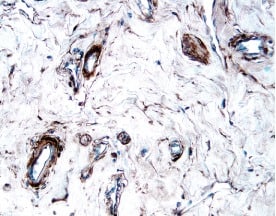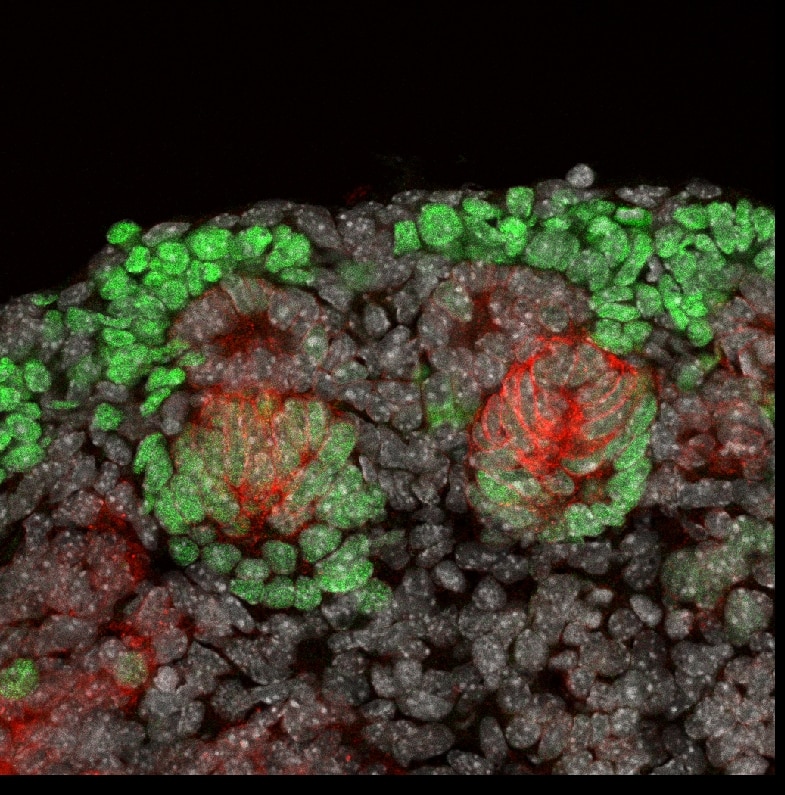Rat Jagged 1 Antibody Summary
Ser32-Asp1068 (Gly57-Arg59 del, Asp63Thr, Arg64Leu, and Val-Arg-Pro-Tyr ins before Lys69)
Accession # Q63722
Customers also Viewed
Applications
under non-reducing conditions only
Rat Jagged 1 Sandwich Immunoassay
Please Note: Optimal dilutions should be determined by each laboratory for each application. General Protocols are available in the Technical Information section on our website.
Scientific Data
 View Larger
View Larger
Differentiation Induced by Jagged 1 and Neutralization by Rat Jagged 1 Antibody. Recombinant Rat Jagged 1 Fc Chimera (Catalog # 599-JG) induces differentiation in the C3H10T1/2 mouse embryonic fibroblast cell line in the presence of Recombinant Human BMP-2 (Catalog # 355-BM) in a dose-dependent manner (orange line), as measured by alkaline phosphatase activity. Differentiation elicited by Recombinant Rat Jagged 1 Fc Chimera (3 µg/mL) in the presence of Recombinant Human BMP-2 (150 ng/mL) is neutralized (green line) by increasing concentrations of Goat Anti-Rat Jagged 1 Antigen Affinity-purified Polyclonal Antibody (Catalog # AF599). The ND50 is typically 3-15 µg/mL.
Preparation and Storage
- 12 months from date of receipt, -20 to -70 °C as supplied.
- 1 month, 2 to 8 °C under sterile conditions after reconstitution.
- 6 months, -20 to -70 °C under sterile conditions after reconstitution.
Background: Jagged 1
Rat Jagged 1 was the first ligand for Notch identified in mammals. Since both the ligands and receptors are transmembrane proteins, direct cell-cell interactions are thought to be required for activating Notch signaling. Jagged 1 is synthesized as a precursor protein that contains a 21 aa signal sequence, a 1048 aa extracellular region, a 25 aa transmembrane (TM) segment and a short, 226 aa cytoplasmic domain. The large extracellular region has a DSL (Delta, Serrate, Lag-2 consensus sequence) domain followed by 16 EGF-like repeats, and a cysteine-rich (CR) region (1). The extracellular region of rJagged 1 binds to multiple Notch receptors on the cell surface as well as in solid phase binding studies. The DSL motif is necessary for binding to Notch receptors and the EGF repeats modulate the affinity of the interaction with Notch receptors (2). Notch signaling is implicated in many developmental processes in a variety of cell types. Jagged-Notch signaling specifies cell fate, regulates pattern formation, defines boundaries between different cell types, and modulates cell proliferation and differentiation. Some specific areas where Jagged is involved include hematopoiesis, myogenesis, neurogenesis and development of the vasculature (3). For instance soluble, non-transmembrane forms of Jagged 1 influence behavior in fibroblast cells leading to characteristics exhibited by endothelial cells during angiogenesis (4). Soluble Jagged 1 is also capable of maintaining the survival and enhancing the expansion of human stem cells that are capable of reconstituting hematopoietic lineages in vivo (5). Furthermore, Jagged 1 is implicated in human disease: Alagille syndrome, an autosomal dominant disorder characterized by defects in liver, heart, eye, skeletal, craniofacial tissues, and kidney, is caused by mutations in Jagged 1 (6). Depending on cell types and how soluble forms of the ligand are presented, ligand binding can result in activation or inhibition of Notch signaling (7). Rat Jagged 1 shows 98% and 99% aa identity to human and mouse Jagged 1 extracellular domains respectively. Relative to the extracellular region of rat Jagged 2, the aa identity is 58%.
- Lindsell, C.E. et al. (1995) Cell 80:909.
- Shimizu, K. et al. (1999) J. Biol. Chem. 274:32961.
- Lewis, J. (1998) Stem Cell & Dev. Biol. 9:583.
- Small, D. et al. (2001) J. Biol. Chem. 276:32022.
- Karanu, F. et al. (2000) J. Exp. Med. 192:1365.
- Joutel, A. and E. Tounier-Lasserve (1998) Stem Cell & Dev. Biol. 9:619.
- Hicks, C. et al. (2002) J Neurosci. Res. 68:655.
Product Datasheets
Citations for Rat Jagged 1 Antibody
R&D Systems personnel manually curate a database that contains references using R&D Systems products. The data collected includes not only links to publications in PubMed, but also provides information about sample types, species, and experimental conditions.
26
Citations: Showing 1 - 10
Filter your results:
Filter by:
-
Human iPSC-derived renal organoids engineered to report oxidative stress can predict drug-induced toxicity
Authors: Lawrence M, Elhendawi M, Morlock M et al.
iScience
-
Integrating collecting systems in kidney organoids through fusion of distal nephron to ureteric bud
Authors: Shi, M;Crouse, B;Sundaram, N;Shakked, NP;Ester, L;Zhang, W;Janakiram, V;Kopan, R;Helmrath, MA;Bonventre, JV;McCracken, KW;
bioRxiv : the preprint server for biology
Species: Human
Sample Types: Organoid
Applications: Immunocytochemistry -
Stepwise developmental mimicry generates proximal-biased kidney organoids
Authors: Schnell, J;Miao, Z;Achieng, M;Fausto, CC;Wang, V;Kuyper, F;Thornton, ME;Grubbs, B;Kim, J;Lindström, NO;
bioRxiv : the preprint server for biology
Species: Mouse
Sample Types: Organoid
Applications: Immunohistochemistry -
Measurement of adhesion and traction of cells at high yield (MATCHY) reveals an energetic ratchet driving nephron condensation
Authors: Liu, J;Prahl, LS;Huang, A;Hughes, AJ;
bioRxiv : the preprint server for biology
Species: Mouse
Sample Types: Whole Tissue
Applications: Immunohistochemistry -
?-cell Jagged1 is sufficient but not necessary for islet Notch activity and insulin secretory defects in obese mice
Authors: Suda, N;Bartolomé, A;Liang, J;Son, J;Yagishita, Y;Siebel, C;Accili, D;Ding, H;Pajvani, UB;
Molecular metabolism
Species: Mouse
Sample Types: Whole Tissue
Applications: IHC -
CXCL12 regulates coronary artery dominance in diverse populations and links development to disease
Authors: Rios Coronado, PE;Zanetti, D;Zhou, J;Naftaly, JA;Prabala, P;Kho, PF;Martínez Jaimes, AM;Hilliard, AT;Pyarajan, S;Dochtermann, D;Million Veteran Program, ;Chang, KM;Winn, VD;Pa?ca, AM;Plomondon, ME;Waldo, SW;Tsao, PS;Clarke, SL;Red-Horse, K;Assimes, TL;
medRxiv : the preprint server for health sciences
Species: Mouse, Transgenic Mouse
Sample Types: Whole Tissue
Applications: Immunohistochemistry -
Bmp9 regulates Notch signaling and the temporal dynamics of angiogenesis via Lunatic Fringe
Authors: Ristori, T;Thuret, R;Hooker, E;Quicke, P;Lanthier, K;Ntumba, K;Aspalter, IM;Uroz, M;Herbert, SP;Chen, CS;Larrivée, B;Bentley, K;
bioRxiv : the preprint server for biology
Species: Human
Sample Types:
-
The onset of circulation triggers a metabolic switch required for endothelial to hematopoietic transition
Authors: E Azzoni, V Frontera, G Anselmi, C Rode, C James, EM Deltcheva, AS Demian, J Brown, C Barone, A Patelli, JR Harman, M Nicholls, SJ Conway, E Morrissey, SEW Jacobsen, DB Sparrow, AL Harris, T Enver, MFTR de Bruijn
Cell Reports, 2021-12-14;37(11):110103.
Species: Mouse, Transgenic Mouse
Sample Types: Whole Tissue
Applications: IHC -
Hepatocyte TLR4 triggers inter-hepatocyte Jagged1/Notch signaling to determine NASH-induced fibrosis
Authors: Junjie Yu, Changyu Zhu, Xiaobo Wang, KyeongJin Kim, Alberto Bartolome, Paola Dongiovanni et al.
Science Translational Medicine
-
A beta -catenin-driven switch in TCF/LEF transcription factor binding to DNA target sites promotes commitment of mammalian nephron progenitor cells
Authors: Qiuyu Guo, Albert Kim, Bin Li, Andrew Ransick, Helena Bugacov, Xi Chen et al.
eLife
-
BMP9 signaling promotes the normalization of tumor blood vessels
Authors: C Viallard, C Audiger, N Popovic, N Akla, K Lanthier, I Legault-Na, H Melichar, S Costantino, S Lesage, B Larrivée
Oncogene, 2020-02-10;0(0):.
Species: Human
Sample Types: Cell Lysates
Applications: Western Blot -
Notch signalling defines dorsal root ganglia neuroglial fate choice during early neural crest cell migration
Authors: S Wiszniak, Q Schwarz
BMC Neurosci, 2019-04-29;20(1):21.
Species: Mouse
Sample Types: WholeTissue
Applications: IHC-F -
SMAD4 prevents flow induced arterial-venous malformations by inhibiting Casein Kinase 2
Authors: Roxana Ola, Sandrine H. Künzel, Feng Zhang, Gael Genet, Raja Chakraborty, Laurence Pibouin-Fragner et al.
Circulation
-
Muscle Satellite Cell Cross-Talk with a Vascular Niche Maintains Quiescence via VEGF and Notch Signaling
Authors: M Verma, Y Asakura, BSR Murakonda, T Pengo, C Latroche, B Chazaud, LK McLoon, A Asakura
Cell Stem Cell, 2018-10-04;23(4):530-543.e9.
Species: Mouse
Sample Types: Whole Cells
Applications: Flow Cytometry -
Conserved and Divergent Molecular and Anatomic Features of Human and Mouse Nephron Patterning
Authors: Nils O. Lindström, Tracy Tran, Jinjin Guo, Elisabeth Rutledge, Riana K. Parvez, Matthew E. Thornton et al.
Journal of the American Society of Nephrology
-
DACH1 stimulates shear stress-guided endothelial cell migration and coronary artery growth through the CXCL12–CXCR4 signaling axis
Authors: Andrew H. Chang, Brian C. Raftrey, Gaetano D'Amato, Vinay N. Surya, Aruna Poduri, Heidi I. Chen et al.
Genes & Development
-
PI3 kinase inhibition improves vascular malformations in mouse models of hereditary haemorrhagic telangiectasia
Nat Commun, 2016-11-29;7(0):13650.
Species: Mouse
Sample Types: Whole Tissue
Applications: IHC -
Hippo signaling interactions with Wnt/ beta -catenin and Notch signaling repress liver tumorigenesis
Authors: Wantae Kim, Sanjoy Kumar Khan, Jelena Gvozdenovic-Jeremic, Youngeun Kim, Jason Dahlman, Hanjun Kim et al.
Journal of Clinical Investigation
-
Vascular Notch proteins and Notch signaling in the peri-implantation mouse uterus
Authors: Carrie J. Shawber, Lu Lin, Maria Gnarra, Mark V. Sauer, Virginia E. Papaioannou, Jan K. Kitajewski et al.
Vascular Cell
-
Pericytes are progenitors for coronary artery smooth muscle
Authors: Katharina S Volz, Andrew H Jacobs, Heidi I Chen, Aruna Poduri, Andrew S McKay, Daniel P Riordan et al.
eLife
-
Cadherin-based adhesions in the apical endfoot are required for active Notch signaling to control neurogenesis in vertebrates.
Authors: Hatakeyama J, Wakamatsu Y, Nagafuchi A, Kageyama R, Shigemoto R, Shimamura K
Development, 2014-04-01;141(8):1671-82.
Species: Mouse
Sample Types: Whole Tissue
Applications: IHC -
OX40L/Jagged1 Cosignaling by GM-CSF–Induced Bone Marrow-Derived Dendritic Cells Is Required for the Expansion of Functional Regulatory T Cells
Authors: Anupama Gopisetty, Palash Bhattacharya, Christine Haddad, Joseph C. Bruno, Chenthamarakshan Vasu, Lucio Miele et al.
The Journal of Immunology
-
ALK1 Signaling Inhibits Angiogenesis by Cooperating with the Notch Pathway
Authors: Bruno Larrivée, Claudia Prahst, Emma Gordon, Raquel del Toro, Thomas Mathivet, Antonio Duarte et al.
Developmental Cell
-
Roles of Pofut1 and O-fucose in mammalian Notch signaling.
Authors: Stahl M, Uemura K, Ge C, Shi S, Tashima Y, Stanley P
J. Biol. Chem., 2008-03-17;283(20):13638-51.
Species: Rat
Sample Types: Whole Cells
Applications: Flow Cytometry -
Intraoperative delivery of the Notch ligand Jagged-1 regenerates appendicular and craniofacial bone defects
Authors: DW Youngstrom, R Senos, RL Zondervan, JD Brodeur, AR Lints, DR Young, TL Mitchell, ME Moore, MH Myers, WJ Tseng, KM Loomes, KD Hankenson
NPJ Regen Med, 2017-12-15;2(0):32.
-
Single-Cell Profiling Reveals Sex, Lineage, and Regional Diversity in the Mouse Kidney.
Authors: Ransick, A, LindstrOm, N O Et al.
Dev Cell
FAQs
No product specific FAQs exist for this product, however you may
View all Antibody FAQsIsotype Controls
Reconstitution Buffers
Secondary Antibodies
Reviews for Rat Jagged 1 Antibody
Average Rating: 5 (Based on 1 Review)
Have you used Rat Jagged 1 Antibody?
Submit a review and receive an Amazon gift card.
$25/€18/£15/$25CAN/¥75 Yuan/¥2500 Yen for a review with an image
$10/€7/£6/$10 CAD/¥70 Yuan/¥1110 Yen for a review without an image
Filter by:






















